5 Ways to Reduce Corporate Carbon Footprint in 2024
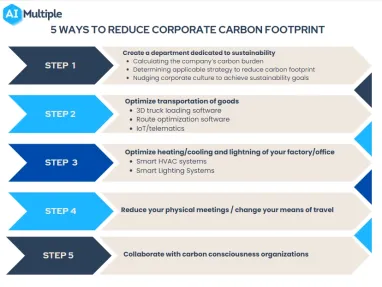
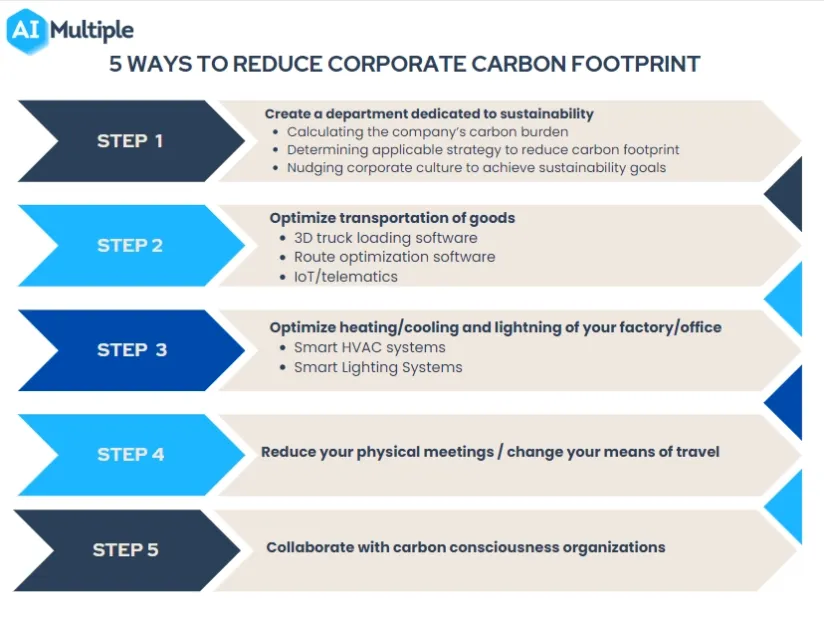
As a result of climate change, extreme weather events are becoming five times more common than they were 50 years ago, posing a threat to our global civilizations. As a result, politicians‘, consumers‘, and funders‘ expectations regarding climate-neutral corporate actions skyrocketed.
However, only 27% of major enterprises and 9% of SMEs, according to the British Chamber of Commerce, have strategies to minimize their organizations’ carbon footprints. This article offers the top 5 carbon footprint reduction best practices to aid businesses in determining the strategies that will enable them to achieve net-zero emissions.
1. Create a department dedicated to sustainability
It would be naïve to suppose that a corporation can change its style of doing business without changing its organizational structure. In this regard, businesses should establish sustainability departments led by a chief sustainability officer (CSO) to reduce their corporate carbon footprint.
The followings are the key responsibilities of the sustainability department:
1.1 Calculating the company’s carbon burden
The first step in decreasing an organization’s carbon footprint is to calculate its carbon footprint and its products’ carbon footprint to discover inefficiencies in greenhouse gas emissions. The Sustainability department should be in charge of determining how to compute carbon footprint (e.g inhouse measurement, using cloud based tools and carbon footprint software, working with consultant firms etc).
It is important to mention that, for many industries up to 95% GHG emissions are embedded in downstream and upstream supply chain activities (see Figure 2). Thus, calculating GHG emissions accurately is related to supply chain visibility. Using ERP systems or blockchain technology can help companies to transparently share their supply chain activities.
Figure 2: For many firms indirect emissions make the bulk of GHG emissions.
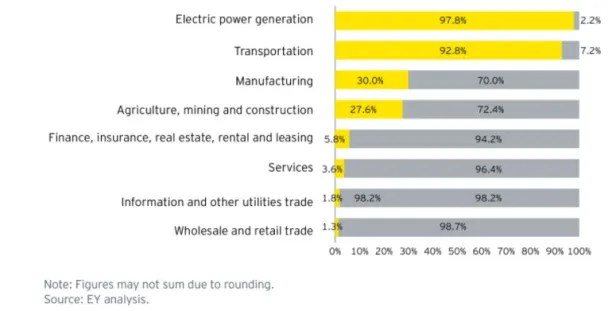
To learn more regarding supply chain visibility you can read our Top 5 Steps To Improve Supply Chain Visibility article.
1.2 Determining applicable strategy to reduce carbon footprint
The sustainability department should set short- and long-term carbon emission targets, as well as a feasible strategy to meet these targets, using data from carbon footprint calculations. By leveraging cloud technologies that specialize in sustainability-related topics, the department may run simulations and review the success of its plan by analyzing its carbon impact on a regular basis.
1.3 Preparing ESG Reports
As with their financial reports, businesses should create environmental, social, and governance (ESG) reports to highlight their sustainability indicators and advancement. The Sustainability department should determine which ESG standards to follow (e.g GRI) and validate data for the reliability of reports.
Preparing high quality ESG reports is crucial for firms longevity. Since following benefits arise from publishing ESG reports and finding workable solutions for corporate sustainability challenges:
- Improve branding: According to PwC, half of the customers Google sustainable management practices of firms before doing purchases.
- Reduce stock prices fluctuations: Nasdaq’s research found that ESG consciousness firms are impacted less from stock market fluctuations (see Figure 3).
- A strategy to combat with great resignation: According to Marshmclennan, the amount of carbon emissions of a company is negatively associated with employee satisfaction.
Figure 3: ESG reports’ impact on financial performance.
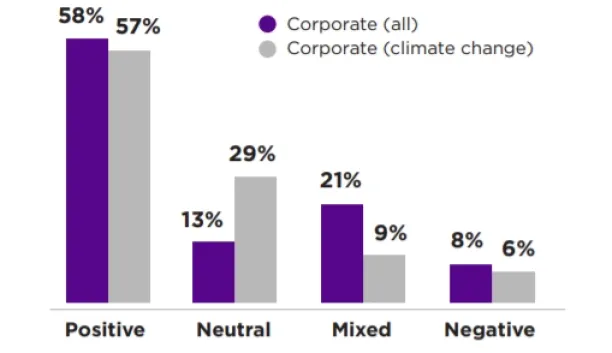
AIMultiple expects that in the near future ESG reports’ benefits will increase since sustainability consciousness millennials’ and gen Z’s proportion in population is increasing.
To learn more regarding ESG reporting best practices you can read our Top 6 ESG & Sustainability Reporting Best Practices article.
1.4 Nudging corporate culture to achieve sustainability goals
Having an enabling corporate culture has a favorable impact on firms’ ability to achieve their objectives. In this case, the sustainability department could host educational seminars to raise staff understanding and awareness of environmental issues. Companies can encourage their staff to adopt a “reduce, reuse, and recycle” mindset. To reduce waste, businesses might utilize recycled paper and urge employees to bring their own cups. To foster a sense of pro-environmental community, the department can organize activities such as tree planting.
2. Optimize transportation of goods
Transportation is the second-largest source of industry related carbon emissions (see Figure 4), accounting for more than 15% of total US carbon emissions. As a result, improvements in product transportation can lower your company’s carbon footprint dramatically.
Figure 4: US energy related CO2 emission.
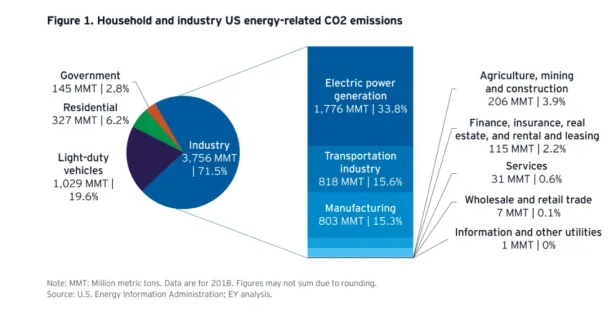
It is possible to reduce CO2 emissions caused by goods distribution and transportation costs by implementing the following technologies:
- 3D truck loading software: These applications allow you to visualize the cargo area and organize it in the most efficient way possible by maximizing every available space. As a result, such tools assist fleet managers or company fleets in transporting as much goods as feasible while decreasing carbon emissions by reducing the number of transportation vehicles or number of trips.
- Route optimization software: These tools are designed to make transportation more efficient when there are several stops. Different criteria such as time, cost, and fuel can all be considered when optimizing. If you choose the most fuel-efficient route, your carbon footprint will be minimized.
- IoT/telematics: Truck/automobiles are used by fleet managers, company fleets, and field sales teams on a daily basis. Data about engine or tyre performance deterioration, as well as driver behavior, can be collected using the Internet of Things. Vehicles can be maintained in this regard if their performance degrades, or drivers can be encouraged to drive in a more ecologically responsible manner. As we mentioned in our 31 case studies on digital transformation. In 2013, Michelin launched such an endeavor, which resulted in fuel savings of 2.5 liters per 100 kilometers per vehicle.
- Adopting electric vehicles: Switching fuel-burning fleets to electric vehicles reduces carbon footprint dramatically, especially in areas where the bulk of electricity is generated by ecologically friendly sources such as wind or sun.
To learn more about how you can increase both efficiency and sustainability of your supply chain you can read our Top 5 Technologies Improving Supply Chain Sustainability article.
3. Optimize heating/cooling and lightning of your factory/office
Offices and factories are a source of carbon pollution due to ineffective heating/cooling and lightning infrastructure. By using technology and taking easy measures you can reduce your corporate carbon footprints.
- Smart HVAC systems: Heating, ventilation, and air conditioning systems can be fitted with smart sensors that connect with the building automation system and can be programmed to reduce energy usage while maintaining a comfortable working environment. When buildings or rooms are empty, such systems can cut energy consumption for HVAC activities and take into account everyday workplace routines to find optimal activity level.
- Smart Lighting Systems: Using sensors, you can optimize the length of your lightning, much like you can with HVAC systems. When no one is in the office, factory, or restroom, these systems turn off the lights. They adjust the brightness of the lighting to the level of darkness in the room. For example, if your office receives direct sunshine, using bright lighting during the noon hour is inefficient. Additionally, by replacing your incandescent bulbs with eco-friendly LED bulbs, you can lessen your company’s carbon footprint.
To learn more about how digital transformation can reduce your environmental burden while improving business efficiency you can read our Top 4 Digital Technologies that Improve Corporate Sustainability article.
4. Reduce your physical meetings and change your means of travel
The CO2 emissions per kilometer per person vary enormously depending on the mode of travel (see Figure 5). Regardless, each of them emits a certain quantity of CO2.
Figure 5: Carbon Footprint of Travel
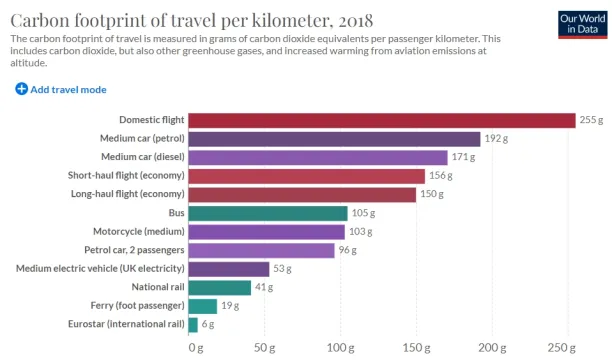
Statistics show that around 76% of Americans drive alone to work every day. Many companies fly first class to attend international meetings. Covid, on the other hand, demonstrated how to manage our work utilizing online meeting technologies like Zoom, Google Meetings, and Microsoft Teams. As a result, companies can reduce their carbon footprint by implementing remote or hybrid working.
Companies can nevertheless lower their carbon footprint in circumstances where physical teaching is required. Workers from nearby places, for example, can carpool. Because business class seats take up more space than economy class seats, business class flights emit up to three times more carbon than economy class flights. So companies should encourage their workers to prefer economy class flights. Trains are also one of the most environmentally friendly modes of transportation, so they may help business travelers reduce their carbon footprint.
5. Collaborate with carbon consciousness organizations
The fight against global climate change extends beyond the acts of particular entities. We must work collaboratively as a community in order to establish a positive feedback loop. The ideal way to achieve this is to reward collaborations with other environmentally conscious firms by acquiring electricity, raw materials, intermediate goods, financial services, and other necessities for your everyday operations. By doing so, your firm not only contributes to becoming a part of the solution, but it also reduces its carbon footprint because indirect GHG emissions are reduced.
Many businesses have already made their environmental impact public. For example, more than 4500 firms declared their GHG emissions as their will in 2020; due to laws such as CSRD, this figure will soon climb. According to Ey, European firms will be required to publish their ESG reports that include information about carbon footprint by 2023.
Many certificates exist that show an organization’s environmental impact. Renewable Energy Guarantees of Origin (REGO), for example, offers data on the proportion of renewable energy in electricity. Your firm should pick suppliers by checking such information tools to reduce its carbon footprint.
Remember that, in addition to environmental challenges, there are also global social issues. You can examine your ESG position and set measures to enhance it by calculating metrics we mentioned in our article Top 14 ESG Metrics CEOs Must Disclose in ESG Reports.
We can assist you with more information about lowering your carbon footprint:

Cem has been the principal analyst at AIMultiple since 2017. AIMultiple informs hundreds of thousands of businesses (as per similarWeb) including 60% of Fortune 500 every month.
Cem's work has been cited by leading global publications including Business Insider, Forbes, Washington Post, global firms like Deloitte, HPE, NGOs like World Economic Forum and supranational organizations like European Commission. You can see more reputable companies and media that referenced AIMultiple.
Throughout his career, Cem served as a tech consultant, tech buyer and tech entrepreneur. He advised businesses on their enterprise software, automation, cloud, AI / ML and other technology related decisions at McKinsey & Company and Altman Solon for more than a decade. He also published a McKinsey report on digitalization.
He led technology strategy and procurement of a telco while reporting to the CEO. He has also led commercial growth of deep tech company Hypatos that reached a 7 digit annual recurring revenue and a 9 digit valuation from 0 within 2 years. Cem's work in Hypatos was covered by leading technology publications like TechCrunch and Business Insider.
Cem regularly speaks at international technology conferences. He graduated from Bogazici University as a computer engineer and holds an MBA from Columbia Business School.
To stay up-to-date on B2B tech & accelerate your enterprise:
Follow on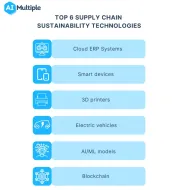
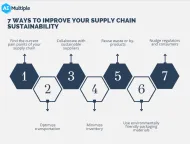
Comments
Your email address will not be published. All fields are required.